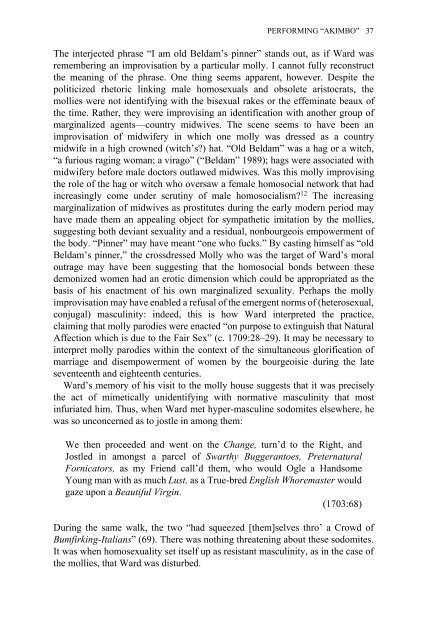Edited by Moe Meyer - Get a Free Blog
Edited by Moe Meyer - Get a Free Blog
Edited by Moe Meyer - Get a Free Blog
Create successful ePaper yourself
Turn your PDF publications into a flip-book with our unique Google optimized e-Paper software.
PERFORMING “AKIMBO” 37<br />
The interjected phrase “I am old Beldam’s pinner” stands out, as if Ward was<br />
remembering an improvisation <strong>by</strong> a particular molly. I cannot fully reconstruct<br />
the meaning of the phrase. One thing seems apparent, however. Despite the<br />
politicized rhetoric linking male homosexuals and obsolete aristocrats, the<br />
mollies were not identifying with the bisexual rakes or the effeminate beaux of<br />
the time. Rather, they were improvising an identification with another group of<br />
marginalized agents—country midwives. The scene seems to have been an<br />
improvisation of midwifery in which one molly was dressed as a country<br />
midwife in a high crowned (witch’s?) hat. “Old Beldam” was a hag or a witch,<br />
“a furious raging woman; a virago” (“Beldam” 1989); hags were associated with<br />
midwifery before male doctors outlawed midwives. Was this molly improvising<br />
the role of the hag or witch who oversaw a female homosocial network that had<br />
increasingly come under scrutiny of male homosocialism? 12 The increasing<br />
marginalization of midwives as prostitutes during the early modern period may<br />
have made them an appealing object for sympathetic imitation <strong>by</strong> the mollies,<br />
suggesting both deviant sexuality and a residual, nonbourgeois empowerment of<br />
the body. “Pinner” may have meant “one who fucks.” By casting himself as “old<br />
Beldam’s pinner,” the crossdressed Molly who was the target of Ward’s moral<br />
outrage may have been suggesting that the homosocial bonds between these<br />
demonized women had an erotic dimension which could be appropriated as the<br />
basis of his enactment of his own marginalized sexuality. Perhaps the molly<br />
improvisation may have enabled a refusal of the emergent norms of (heterosexual,<br />
conjugal) masculinity: indeed, this is how Ward interpreted the practice,<br />
claiming that molly parodies were enacted “on purpose to extinguish that Natural<br />
Affection which is due to the Fair Sex” (c. 1709:28–29). It may be necessary to<br />
interpret molly parodies within the context of the simultaneous glorification of<br />
marriage and disempowerment of women <strong>by</strong> the bourgeoisie during the late<br />
seventeenth and eighteenth centuries.<br />
Ward’s memory of his visit to the molly house suggests that it was precisely<br />
the act of mimetically unidentifying with normative masculinity that most<br />
infuriated him. Thus, when Ward met hyper-masculine sodomites elsewhere, he<br />
was so unconcerned as to jostle in among them:<br />
We then proceeded and went on the Change, turn’d to the Right, and<br />
Jostled in amongst a parcel of Swarthy Buggerantoes, Preternatural<br />
Fornicators, as my Friend call’d them, who would Ogle a Handsome<br />
Young man with as much Lust, as a True-bred English Whoremaster would<br />
gaze upon a Beautiful Virgin.<br />
(1703:68)<br />
During the same walk, the two “had squeezed [them]selves thro’ a Crowd of<br />
Bumfirking-Italians” (69). There was nothing threatening about these sodomites.<br />
It was when homosexuality set itself up as resistant masculinity, as in the case of<br />
the mollies, that Ward was disturbed.


